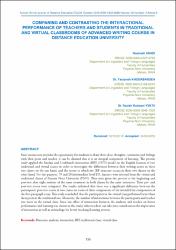Comparing and contrasting the interactional performance of teachers and students in traditional and virtual classrooms of advanced writing course in distance education university

View/
Access
info:eu-repo/semantics/openAccessAttribution-NonCommercial 3.0 United Stateshttp://creativecommons.org/licenses/by-nc/3.0/us/Date
2019Metadata
Show full item recordCitation
Asadi, N., Khodabandeh, F., Yekta, R. R. (2019).Comparing and contrasting the interactional performance of teachers and students in traditional and virtual classrooms of advanced writing course in distance education university. TOJDE 20 (4), 135-148.Abstract
Since interaction provides the opportunity for students to share their ideas, thoughts, comments and feelings
with their peers and teacher, it can be claimed that it is an integral component of learning. The present
study applied the Sinclair and Coulthard’s interaction (IRF) (1975) model on the English learners of two
traditional and virtual classes in order to investigate the differences between their writing scores in these
two classes on the one hand, and the extent to which the IRF structure occurs in these two classes on the
other hand. For this purpose, 79 and 20 intermediate level EFL learners were selected from the virtual and
traditional classes of Payame Noor University (PNU). They were given the pre-test at the beginning and
post-test after eight sessions of the same treatment in both classes by the same instructor. Their pre- and
post-test scores were compared. The results indicated that there was a significant difference between the
participants’ post-test scores in two classes in terms of three components of the intended six components of
the five-paragraph essay. This study concluded that the participants in the virtual class performed better than
their peers in the traditional one. Moreover, the number of interactions between the participants and teacher
was more in the virtual class. Since the effect of interaction between the students and teacher on better
performance and learning was shown in this study, other teachers can take into consideration the importance
of interaction as well as technology for better teaching-learning process.
Source
Turkish Online Journal of Distance Education-TOJDEVolume
20Issue
4Collections
The following license files are associated with this item:


















